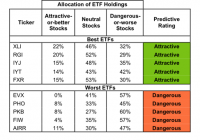Lipper U.S. Fund Flows: Risk-On Despite Uncertainties
By Tom Roseen During the fund-flows week ended October 21, 2015, investors pushed the markets back and forth without strong conviction either way. Third quarter earnings news was hit and miss, with growth fears at the back of investors’ minds. Mixed economic reports kept many on the sidelines, with the Federal Reserve’s Beige Book and the October Philadelphia Fed manufacturing index magnifying fears about the economic recovery. Offsetting those worries during the week, the number people applying for first-time jobless benefits fell for the most recent week, coming in below expectations. Gains in defensive sectors during the flows week helped prop up the major indices to highs not seen since August, sending them to their third straight week (Friday to Friday) of gains. The Shanghai composite posted a 6.5% weekly return as some investors looked to Beijing to continue to provide more stimuli to the Chinese economy. Nonetheless, expectations of a slowing global economy kept oil prices in the cellar. On Monday, October 19, global markets reacted cautiously to news that Chinese economic growth slowed to 6.9% for Q3, beating expectations but missing Beijing’s target. The reported slowdown in fixed-asset investments and industrial production weighed heavily on the price of oil, pushing it down to $45.89 per barrel. This sharp decline pressured oil stocks as well. Despite reports coming out during the latter portion of the flows week of a jump in home builder confidence in October and housing starts being near eight-year highs, mixed corporate results, China’s slowing growth, the EIA’s report of a big jump in crude oil supplies, and the Fed’s inaction kept some investors wary. Nonetheless, investors were net purchases of fund assets (including those of conventional funds and exchange-traded funds (ETFs), injecting a net $6.3 billion for the fund-flows week ended October 21, 2015. Investors turned their back on money market funds, redeeming $2.6 billion for the week, but they were net purchasers of the other three fund macro-groups, injecting some $4.4 billion into taxable bond funds, $4.3 billion into equity funds, and $0.2 billion into municipal bond funds for the week. For the second week in a row equity ETFs witnessed net inflows, taking in $4.5 billion. Despite continued concerns about the Q3 earnings season, authorized participants (APs) were net purchasers of domestic equity ETFs (+$3.2 billion), injecting money into the group for a second consecutive week. They also padded the coffers of nondomestic equity ETFs (to the tune of +$1.3 billion) for the sixth week running. As a result of the relative increase in risk-seeking behavior at the beginning of the week, APs turned their attention to a broad spectrum of domestic equity offerings, with the iShares Russell 2000 ETF (NYSEARCA: IWM ) (+$0.6 billion), the SPDR S&P MidCap 400 ETF (NYSEARCA: MDY ) (+$0.4 billion), and surprisingly-given the slide in oil prices for the week – the Energy Select Sector SPDR ETF (NYSEARCA: XLE ) (+$0.4 billion) attracting the largest amounts of net new money of all individual domestic equity ETFs. At the other end of the spectrum the SPDR S&P 500 ETF (NYSEARCA: SPY ) (-$424 million) experienced the largest net redemptions, while the Industrial Select Sector SPDR ETF (NYSEARCA: XLI ) (-$423 billion) suffered the second largest redemptions for the week. Once again, in contrast to equity ETF investors, for the fourth week in a row conventional fund (ex-ETF) investors were net redeemers of equity funds, redeeming $0.2 billion from the group. Domestic equity funds, handing back $0.8 billion, witnessed their fourth consecutive week of net outflows. Meanwhile, their nondomestic equity fund counterparts witnessed $646 million of net inflows-attracting money for the first week in four. On the domestic side investors lightened up on equity income funds and real estate funds, redeeming a net $0.9 billion and $0.3 billion, respectively, for the week. On the nondomestic side international equity funds witnessed $0.6 billion of net inflows, while emerging market equity funds handed back some $187 million. For the second consecutive week taxable bond funds (ex-ETFs) witnessed net inflows, taking in a little less than $2.3 billion for the week, for their second largest weekly inflows since the week ended May 20, 2015. Corporate investment-grade debt funds suffered the largest redemptions for the week, witnessing net outflows of $0.8 billion (for their thirteenth consecutive week of redemptions), while corporate high-yield funds attracted the largest net new money for the week, taking in $2.3 million (their third largest weekly net inflows on record). For the third week in a row municipal bond funds (ex-ETFs) witnessed net inflows, taking in $148 million this past week.
